Chapter 1The Rise of Programmatic SEO
SEO is undergoing a major shift. Large language models (LLMs) are becoming more intelligent, processing context and adapting to real-world changes faster than humans. As a result, programmatic SEO (pSEO) has emerged as a more efficient and scalable alternative to traditional SEO strategies that rely on manual content creation.
A growing number of success stories highlight how effective pSEO is in targeting long-tail queries as well as reacting to changes in real time. Coupled with its cost-effectiveness, pSEO is beginning to look more and more like the future of content optimization.
“Almost all SEO will become programmatic.”
The appeal of pSEO goes beyond speed and cost efficiency, however. As LLMs continue to evolve, the quality of AI-generated content now often surpasses that of human-created material. In this way, pSEO isn’t just about producing more content faster—it’s about generating content that’s better.
What Is pSEO?
pSEO automates content creation by turning structured data into optimized web pages at scale. It’s often executed to target long-tail search queries that would be too labor-intensive to handle manually. When pSEO is done well, companies can create a vast number of relevant pages quickly and efficiently, all while maintaining a high level of quality.
“Programmatic SEO uses automation and structured data to create a large volume of unique web pages optimized for long-tail keyword variations.”
For an example of pSEO in action, take a look at Zillow. The company uses its real estate database to generate highly specific pages for property listings across the U.S. and Canada. The process is automated, making it easy to not only create but also update listing pages. Doing so ensures that Zillow’s content is always relevant; it does not need to manually create individual pages.
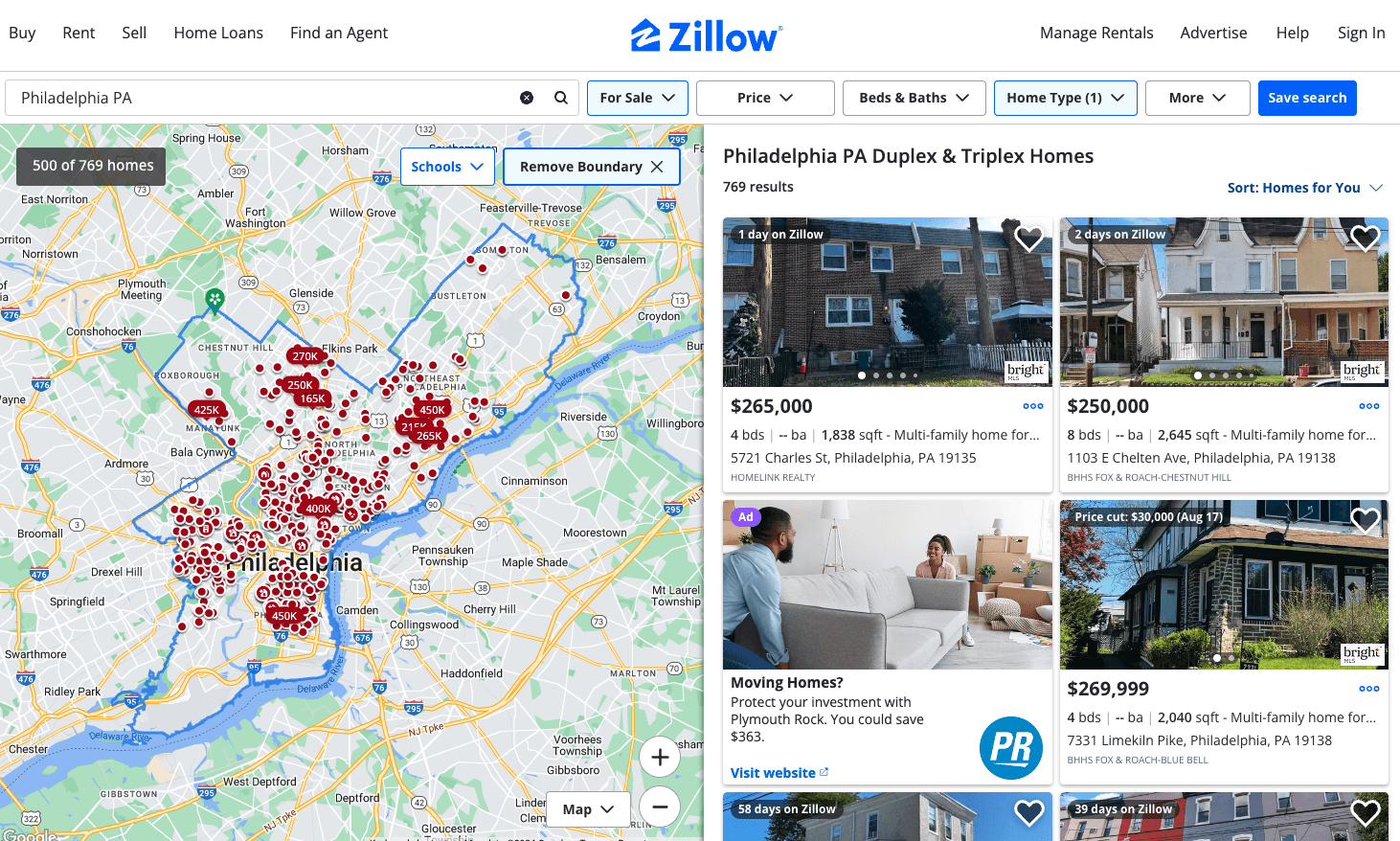
Aside from streamlining content creation, Zillow’s pSEO strategy keeps it far ahead of the competition. Despite launching more than a decade after its rival Realtor.com, it far and away dominates traffic in the real estate space.
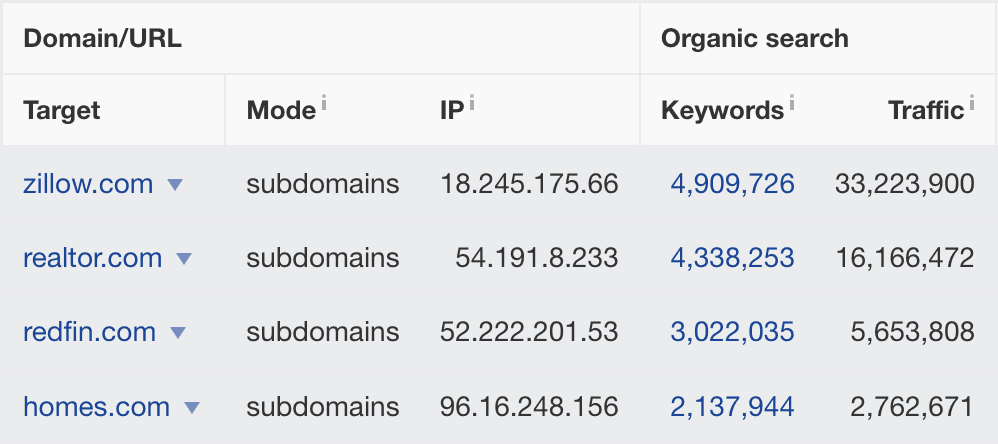
According to John Egan, Head of Growth at Character.ai and former Senior Director of Growth Engineering at Lyft and Pinterest, pSEO thrives in environments where data and engineering intersect. He points to companies like DoorDash, which programmatically generates pages for every restaurant listing.
By leveraging both automation and structured data to scale quickly, pSEO goes far beyond what human teams can manage manually in the same timeframe.
How We Got Here: From Templates to Databases to AI-Enhanced Content Engines
“pSEO has evolved from human writers using templates to leveraging AI for large-scale content production backed by engineering.”
Not all pSEO is one and the same. This strategy encompasses a variety of methods, such as using content templates without full automation and leveraging semi-programmatic techniques to scale content quickly. Some companies create landing pages using dynamic data or semi-automated content blocks—techniques that also fall under the broader umbrella of pSEO.
Just as AI has evolved, so has the execution of programmatic SEO. Early on, pSEO was largely template-based. This approach worked well for generating simple, repeatable content. Many sites that we now recognize as household brands disrupted the web by combining templates with unique databases.
One notable example is Groupon, which used template-based content production to rapidly scale its deal pages by swapping out location- and deal-specific data in predefined templates.
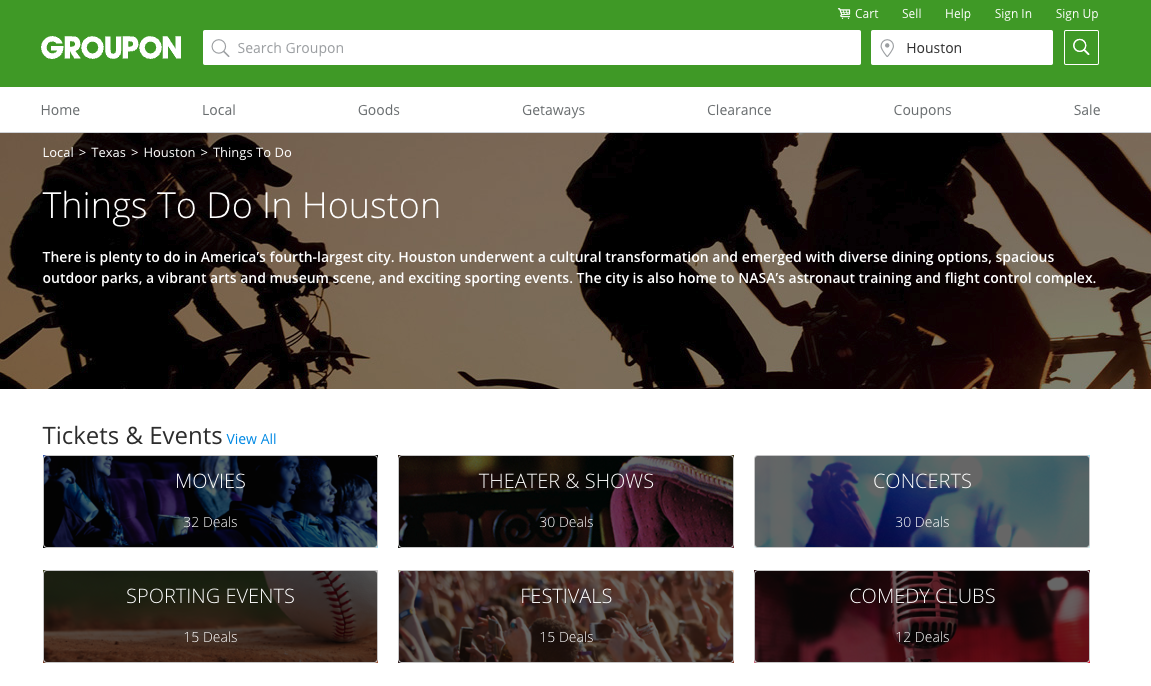
Similarly, Brian Dean, co-founder of Exploding Topics as well as founder of Backlinko, shares how templates were essential in scaling Exploding Topics. His team used just 3–5 templates to produce the site’s content, including the “[#] Growing [Industry] Companies & Startups” page template.

However, while powerful at the time, template-based pSEO strategies often lacked the sophistication to address more complex user intent and personalization needs.
Describing his use of templates to create content for Exploding Topics, Brian says that human judgment remained critical for balancing automation with quality writing. His strategy wasn’t about fully automating everything—it was about efficiency without sacrificing insight.
Zapier’s programmatically created app directory represented the next step in pSEO strategies. Even though the company has long maintained a lively editorial blog, programmatic content is how Zapier famously gained traction—specifically, its pages on how to connect infinite combinations of tools.
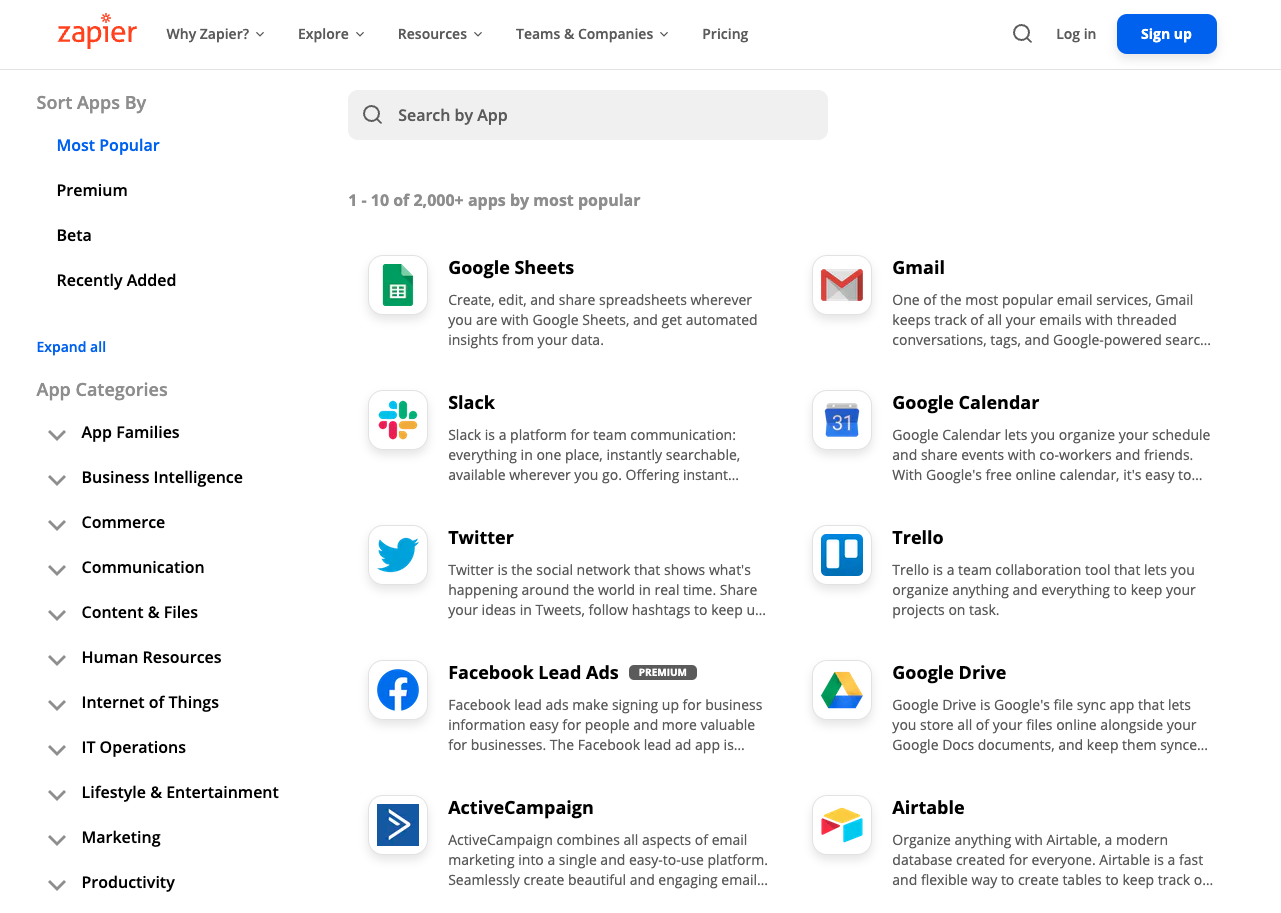
Similarly, the real estate platform Zillow leveraged pSEO by applying the large-scale creation of programmatic template pages to property data from public records. This strategy is what’s made Zillow the ultimate source of insight on buying and selling homes.
The next iteration of pSEO—today’s iteration—introduced AI-enhanced content creation. Note that we use “AI-enhanced” because human input remains essential. However, thanks to modern advancements in machine learning, language models now score high enough in context understanding to personalize content for specific brands, segments, or individuals.
In other words, AI today uses language so well that your programmatic engine can produce content without sacrificing quality. With the help of AI, you can now build a programmatic content engine with deep personalization, context understanding, fast production turnaround, and high writing quality.
Why wasn’t this possible until now?
Earlier attempts to use AI fell short because the technology wasn’t capable of handling complex queries or delivering contextually accurate responses. Improvements in natural language processing and machine learning now allow AI to generate content that aligns more closely with user intent than ever before.
In fact, at daydream, we believe that AI is already capable of producing content that’s even better than what humans can create. That’s why we foresee programmatic content engines with:
- Better automation: AI-driven workflows will further automate content creation while maintaining high quality.
- Improved personalization: AI will provide more tailored experiences for users. Contextual relevance will become central to programmatic content strategies.
- Real-time optimization: pSEO will continuously adapt to shifts in user behavior. Real-time data will drive content updates, keeping it relevant.
With our mission to make AI-enhanced pSEO much easier and faster to implement, daydream is at the forefront of this content transformation.
What pSEO Is Not
“pSEO fundamentally differs from traditional SEO and content marketing—it scales through automation and structured data, not manual effort or editorial strategy.”
Traditional SEO relies on manual efforts such as improving site structure via one-off projects or campaigns to acquire backlinks. In contrast, pSEO automates improvements at scale, growing website depth or building link magnets by leveraging structured data.
To be clear, pSEO is not diametrically opposed to traditional SEO or content marketing. While traditional SEO revolves around creating editorial content using human insights, pSEO offers a scaled approach that pulls insight from databases.
As Jordan Koene, CEO and founder at Previsible and former CEO at Searchmetrics, points out, the best results come from combining multiple approaches. Even the stars of pSEO like G2, Zapier, and Canva publish human-written blog posts and invest in paid link outreach on top of their programmatic content.

pSEO’s long-tail focus creates synergy with other content marketing efforts, particularly those that focus on highly competitive terms. That said, pSEO and traditional SEO are indeed different approaches at their core.
To think of pSEO as simply creating and publishing content at scale is an oversimplification of the strategy. Imagine a company like Salesforce, where customers prefer to read about unique case studies. Its marketing department may focus on producing large volumes of manually curated content through the help of an in-house content team or outsourced writers. Without a programmatic element, however, the strategy does not qualify as pSEO, even if they produce 50 articles per month.
Chapter 2Why Invest in pSEO?
pSEO Wins Thanks to Efficiency and the Long Tail of Search
“Programmatic SEO allows for mass production of content without sacrificing quality.”
pSEO enables mass content production without losing quality by using structured data to target the “long tail” of search queries—the highly specific searches that collectively generate significant amounts of traffic.

Remember our earlier example from Chapter 1: Brian Dean, who founded Exploding Topics and Backlinko. In his growth work on Exploding Topics, Brian relied primarily on programmatic page templates to scale content production.
This approach enabled Brian and his team to create high-quality, competitive content quickly, leading to even more traffic than his well-known project Backlinko in a much shorter time frame.
Traditional SEO that relies on manual content creation methods simply can’t achieve the same level of scalability. By leveraging structured data and automation, pSEO simplifies the content creation process to produce results with less time and effort.
AI Supercharges Programmatic Content—but Human Insight Remains Key
“AI has become good enough to cater to contextual user needs at scale.”
AI has moved beyond creating simple, templated content. Today, it can generate more complex, relevant content faster than human teams.
However, many users are still hesitant to fully embrace AI-generated content, believing it to lack uniqueness and expertise. Indeed, for straightforward topics like weather data, AI-driven content works well. But for more nuanced topics like health advice, programmatic content often lacks the necessary depth, which can make it less appealing.
This highlights that AI should be seen not as the definitive source of truth, but rather, as a tool to aid content creation.
As search expert Eli Schwartz points out, many people see AI-generated content as just words on a page. For truly effective SEO, especially in industries like SaaS, content must focus on the user journey and deliver real value.
In other words, it’s not enough to write content or implement programmatic methods; success depends on understanding and meeting user needs. While AI helps make pSEO strategies more efficient, user experience remains the key to winning in SEO.
Echoing this sentiment, Brian Dean emphasizes that AI alone is not a competitive advantage. Since AI is available to everyone, the true differentiator is human insight or unique data. Particularly in fields like fintech and SaaS, human input is critical to ensure that content is objective, concise, and well-targeted.
AI isn’t perfect—it can sometimes create content that is overly verbose or too positive. The good news is that AI models can now be trained to scale those human adjustments. That said, some level of human involvement will always be necessary, even if to simply refine a piece of content.
Programmatic SEO Makes Your Database into a Gold Mine
“pSEO turns your company’s database into structured, searchable content that is continuously optimized for performance.”
A company’s unique data is a powerful competitive advantage, as it’s information that foundational AI models lack access to. pSEO unlocks the potential of this data by helping transform it into meaningful content. The key is having defensible data that competitors can’t easily copy.
Two examples:
- Pinterest leverages user-generated content, known as “Pins,” to target highly specific search queries like “cozy home inspo” and “Brooklyn street style.”
- Zillow uses its real estate database to create individual property listing pages as well as curated property pages based on location and building type.
Both companies demonstrate how pSEO can turn companies’ unique first-party data into highly targeted, searchable content.
Even better, programmatic SEO can be applied to all kinds of companies. Ethan Smith, CEO at the agency Graphite and former Chief Growth Officer at Yummly, notes that companies in industries like commerce, marketplaces, and local businesses are particularly well-suited to this strategy.
Marketplaces like Etsy and Poshmark, for example, can use pSEO to generate optimized product category pages from individual product listings. These templated pages, in turn, rank for long-tail keywords while also providing shoppers a smooth browsing experience.
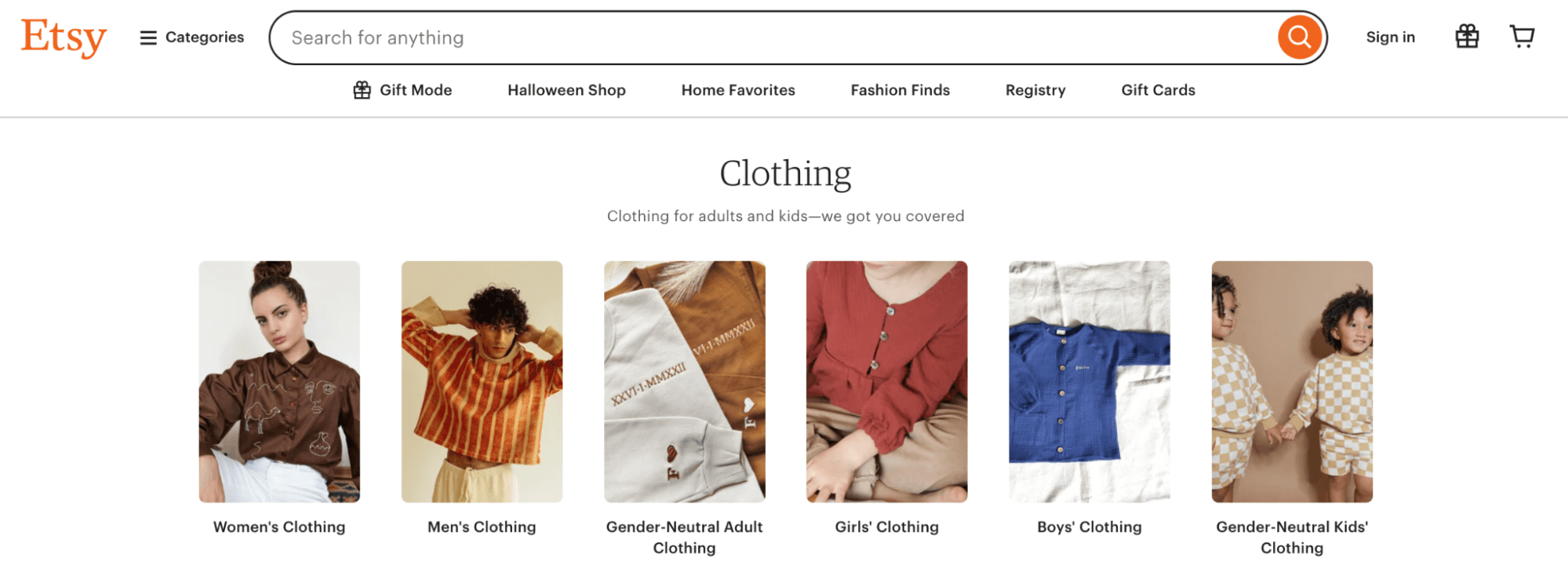
pSEO Reinforces Focus on Feedback Loops
“pSEO allows you to act on opportunities at scale.”
Programmatic SEO enables companies to act quickly on new opportunities. For instance, if a competitor ranks for a topic your site does not currently cover, a programmatic approach can help you quickly produce content, fill the gap, and capture the traffic you might otherwise lose.
Matt Bowers, SEO advisor and former head of SEO at Zapier and Zillow, emphasizes that pSEO thrives on data-driven strategies and feedback loops. Real-time performance data allows for continuous optimization, ensuring that content stays aligned with user intent and market trends.
pSEO’s responsiveness also allows companies to adjust content rapidly. If a particular type of content or word count is underperforming, pSEO helps create or revise content faster, allowing businesses to capitalize on emerging opportunities.
Programmatic SEO Scales Traffic as Well as Business Growth
“pSEO can link to business outcomes and allow you to measure revenue or leads in dollars.”
Programmatic SEO delivers significant results across the entire marketing funnel; its benefits are not limited to one particular stage.
For top-of-the-funnel queries, the sheer volume of traffic from pSEO can be so substantial that it creates a noticeable lift in both revenue and opportunities.
When targeting mid-and bottom-funnel queries, pSEO drives measurable revenue or leads through last-touch attribution. Consider our earlier example of marketplaces like Etsy—programmatically created product category and subcategory pages capture highly specific keywords that reflect strong purchase intent.
No matter what stage of the buyer’s journey you apply it to, pSEO generates valuable ROI. It can boost traffic that converts into dollars as well as attract active customers, all by achieving a scale that manual content approaches simply cannot match.
Chapter 3 Is pSEO Right for You?
Do You Have Access to Unique Data?
“Unique datasets are the foundation of pSEO.”
Access to unique, structured data is the cornerstone of a pSEO strategy. Companies that can leverage proprietary information or large datasets are best positioned to scale their content production.
Why? It’s data that competitors can’t easily replicate.
G2 is a prime example of how access to unique data can fuel pSEO. Users’ ratings and reviews are the basis for its comprehensive library of software product comparisons.
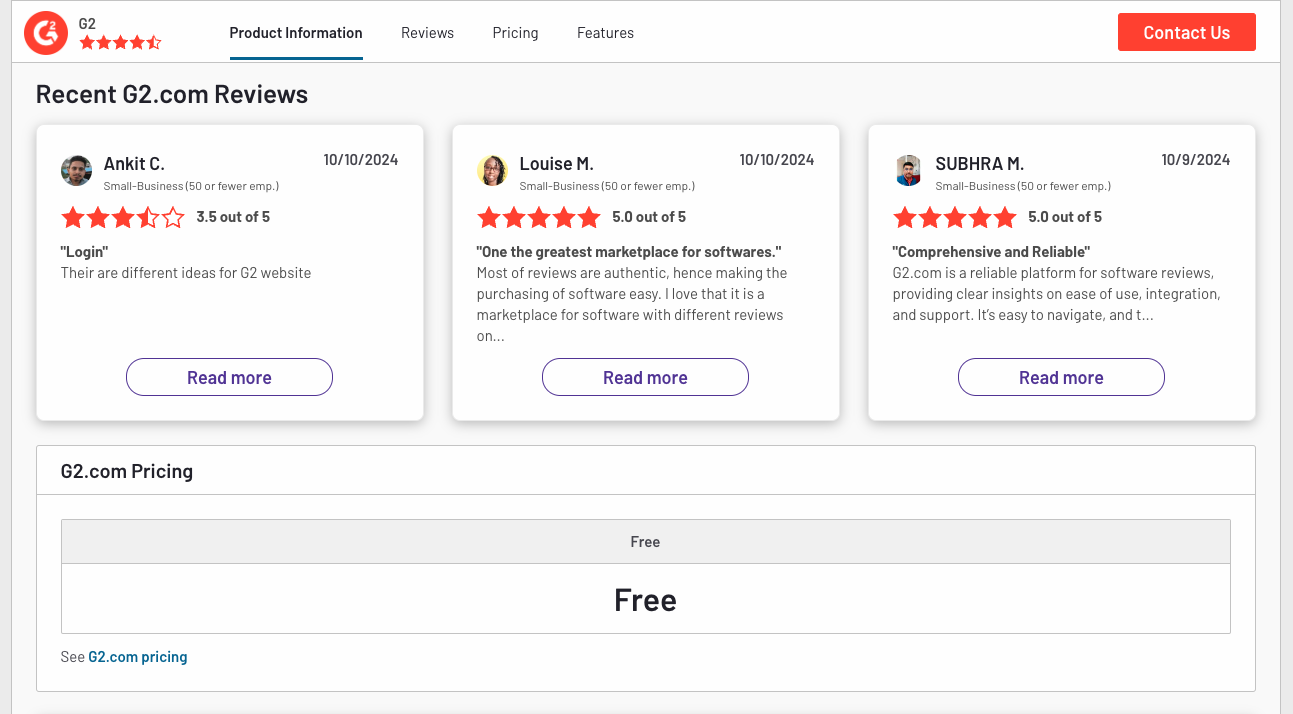
Note that you don’t even need to own the data. You can license it, or you can use data that’s publicly available, like Zillow does. Even G2 pulls product information directly from software companies to show alongside its user ratings and social data.
Similarly, the cybersecurity company Twingate built its own content engine by turning cumbersome government reports about network threats into more user-friendly content for IT professionals. With daydream’s support, Twingate has been able to do this at scale, with more than 1,400 articles created in under seven months.

Sites made up of user-generated content (UGC) are also ideal for pSEO, as the UGC functions as a large dataset. Consider Reddit—its pSEO engine uses user posts and upvotes as data inputs for generating community and topic pages at scale.
Can Your Database Be Structured for pSEO?
“The key to structuring data for pSEO is to organize it around categories that align with user intent or use cases.”
Success in pSEO hinges on how efficiently your data can be organized to generate targeted landing pages, product listings, or other programmatic content. Whether by category, geography, or feature, you must organize your data in ways that reflect how users think.
Zapier illustrates this. By categorizing its app integrations based on user search intent, Zapier created a programmatic engine for SEO that generated pages for each popular combination of apps. Linking Google Sheets to HubSpot is an example of such a page, with thousands of others following the same template.
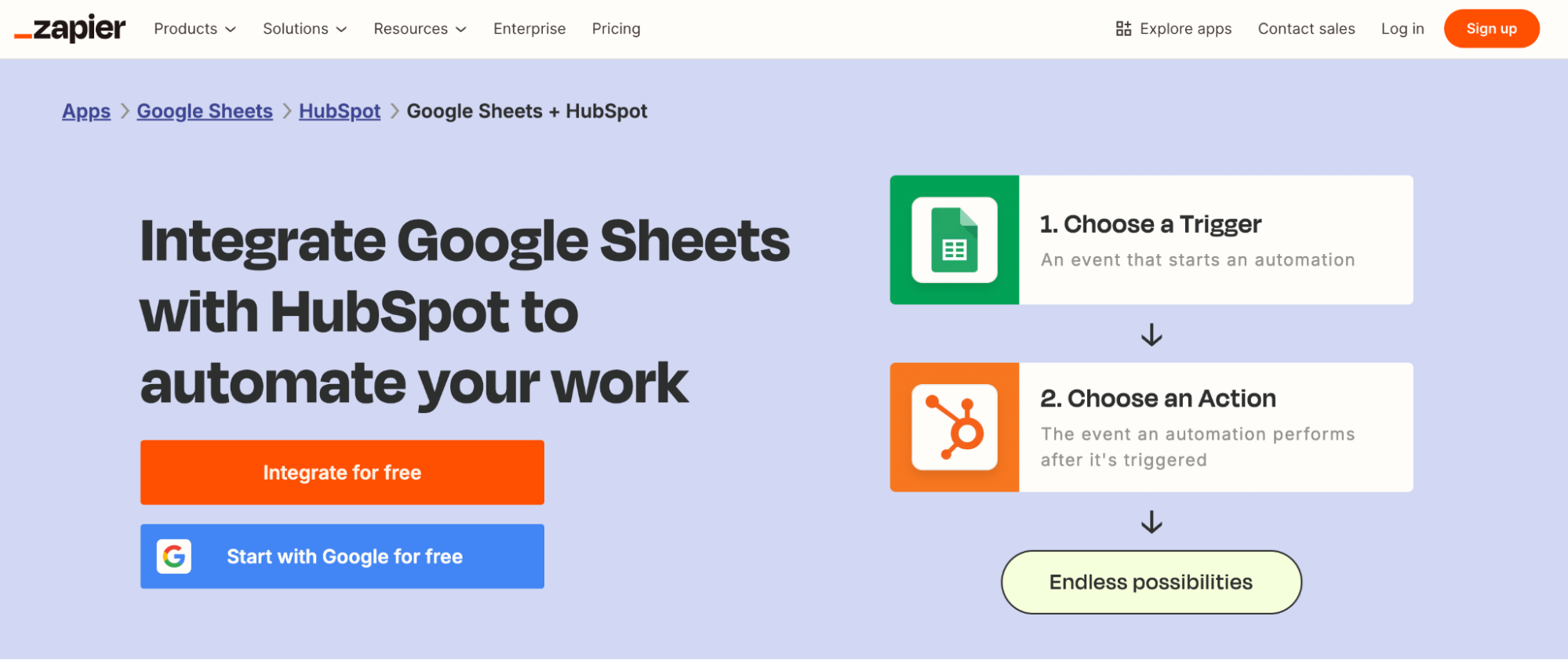
Marketplaces and e-commerce sites are examples of sites where a clear, intuitive structure exists for pSEO. After all, these sites generally tend to organize their listings by product categories, which can then be used as the basis for their programmatic content engines.
Can Your Content Scale without Losing Quality?
The classic challenge with scaling content through pSEO has been in ensuring that it maintains value and depth as volume increases. Not all types of content are suited for programmatic SEO, and understanding which formats scale well is key to maintaining quality at scale.
Below are four examples of content types that scale well through pSEO:
- Directory-style content: Sites that compile services, like Zapier’s app directory, G2’s tool reviews, or Yelp’s local business listings, offer structured information that can be easily converted into programmatic templates.
- Listing pages: Like directories, listings epitomize structured data with their predictable format. Companies like Groupon, Zillow, and TripAdvisor scale by turning such data into rich, localized content.
- User-generated content (UGC): Think communities and review sites. Platforms like Reddit and Pinterest generate massive volumes of searchable content from user contributions.
- Use cases and templates: This is product-centered content that demonstrates how a product can be used. For example, Canva creates design templates that users can duplicate for their own projects. Other companies that have successfully applied pSEO to this type of content include Wise, which creates pages about currency conversion rates, and Airtable, which offers productivity templates.
Is pSEO a Fit for a Specific Stage in Your Funnel?
“Programmatic pages should match user intent at the awareness stage and pull users deeper into your funnel.”
Just like editorial content created for traditional SEO, programmatic SEO is most effective when it aligns with specific stages of the marketing funnel. When content fails to serve a specific funnel stage, it risks becoming irrelevant and diluting the user experience.
To that end, programmatic pages work best when they match user intent and offer meaningful value to your audience.
Let’s take a look at Canva for an example. The graphic design platform creates a wide variety of visual templates, including for infographics, logos, and presentations. Its presentation category alone includes more than 20, 000 templates for specific use cases like sales, pitch decks, product demos, and real estate.
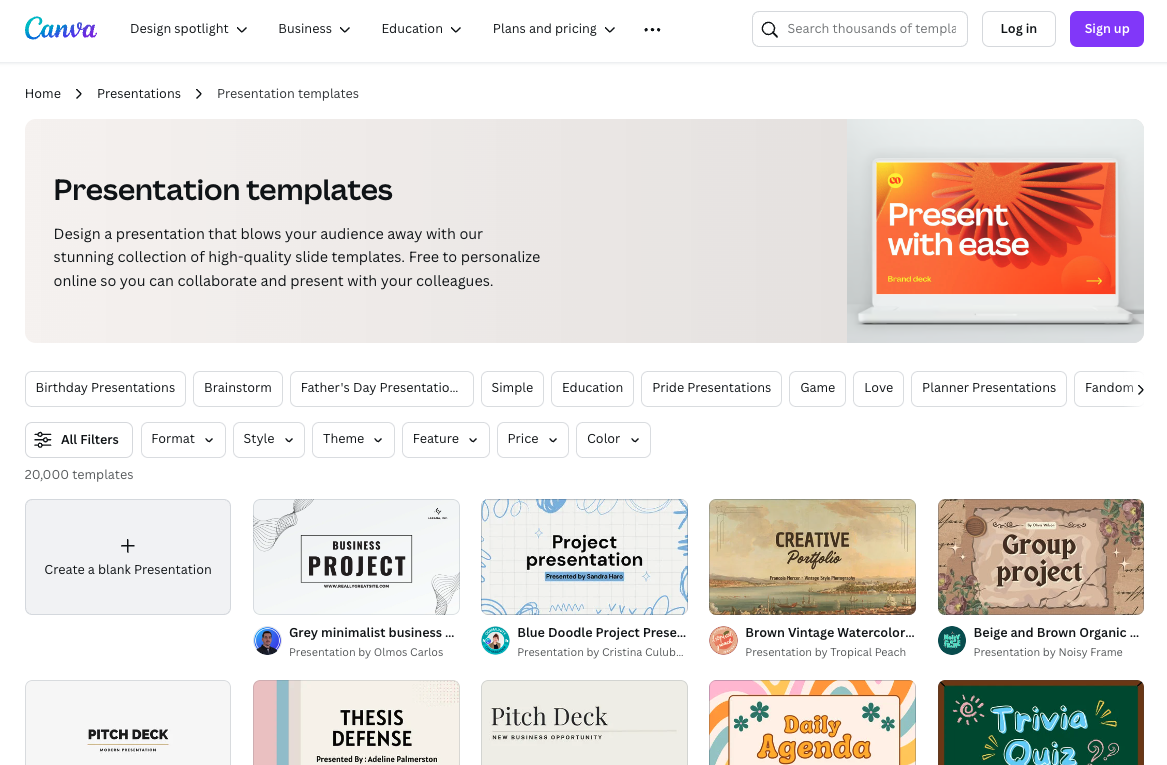
These templates address highly specific user needs and problems, like a founder looking to raise funding from investors or a student trying to meet a project deadline. Searches for these use cases often reflect an intent to purchase or act—and Canva captures them with its programmatically created template pages, showing users the value of its design tool.
By creating pages that address user intent and offering solutions tailored to precise needs, pSEO can help businesses draw users deeper into their funnel and drive meaningful engagement. As in the Canva example, the strategy works best when it delivers relevant, actionable content rather than overwhelming users with generic or unfocused information.
Do You Have Substantial Long-Tail Search Volume?
“Long-tail search queries are the bread and butter of pSEO, driving traffic through high-volume, low-competition terms.”
One of the core ingredients for pSEO success is the presence of long-tail queries—or, to be more specific, low-competition, high-intent queries that are difficult to address through traditional SEO. Think search queries in a topic with endless combinations, but high potential of purchase intent.
One example: crypto conversion rates like “BTC to USD.” Thousands of cryptocurrencies exist alongside fiat money, meaning a nearly infinite number of long-tail conversion searches from curious investors. This provides the basis for Coinbase’s programmatic strategy.

If you find it impossible to cater to a broad variety of relevant terms in your market with editorial content, it may be worth considering pSEO instead. Coupled with access to large-scale data, you can address long-tail queries programmatically and gain visibility across a wide range of topics.
How Does Your Domain Authority Compare to the Competition?
“You need to have domain authority stronger than your SERP competition in order to rank for a large number of long-tail searches.”
If your domain already carries authority for your topic, you will significantly increase your chances of ranking for programmatic content. That’s because Google’s search algorithms value relevance and expertise in websites: if a publisher has no established authority about a particular subject, its content likely won’t be perceived as helpful to users.
However, it’s important to note that what matters most is your domain authority relative to competitors. If it’s similar, you're not at a disadvantage, but a large gap can make ranking more difficult.
In other words, without strong domain authority in a competitive industry, a new startup could publish a large volume of content but fail to outrank incumbents.
Given this, building your domain’s topical authority can help improve the odds of your programmatic content ranking if you’re creating content in a competitive space. However, if your domain authority is fairly low but your space is not highly competitive, pSEO can still help you dominate early.
Do You Have Access to User-Generated Content (UGC)?
“UGC can be a goldmine for pSEO.”
More assets than we think can serve as UGC. Comments and likes on Reddit and other forums and social sites, for instance, count as UGC. Then there are reviews on Yelp or G2, posts on Pinterest, character designs on Character.ai, even customer support tickets in a user community.
Using any of these types of UGC, you can programmatically generate content at scale while meeting the needs of users. One of the greatest upsides to using UGC is that it minimizes, even eliminates, the need for in-house content creation. Users instead act as the content engine for pSEO.
John Egan, former growth leader at Lyft and Pinterest, shares how Pinterest became an impressive example of large-scale UGC. The site was able to attract massive volumes of traffic from Google for its user-curated content in categories like home decor, recipes, and fashion. While John’s engineering team put together the foundation for the structure that users post to, it’s ultimately Pinterest’s UGC that drives its strong search performance.
Are You Ready to Commit Long-Term?
“pSEO is a marathon, not a sprint.”
Programmatic SEO requires a long-term commitment and patience. It’s not a quick-win approach like paid marketing. But as with traditional SEO, pSEO takes time to gain traction. And even more than with traditional SEO, pSEO can deliver substantial rewards in traffic, visibility, and conversions over time.
Because of its longer time to results, however, successful pSEO requires committing long-term rather than expecting immediate results.
Companies that focused on endurance, like Zapier, Airbnb, or Yelp, didn’t see results overnight, but their persistent investment in programmatic SEO paid off and helped them become industry leaders.
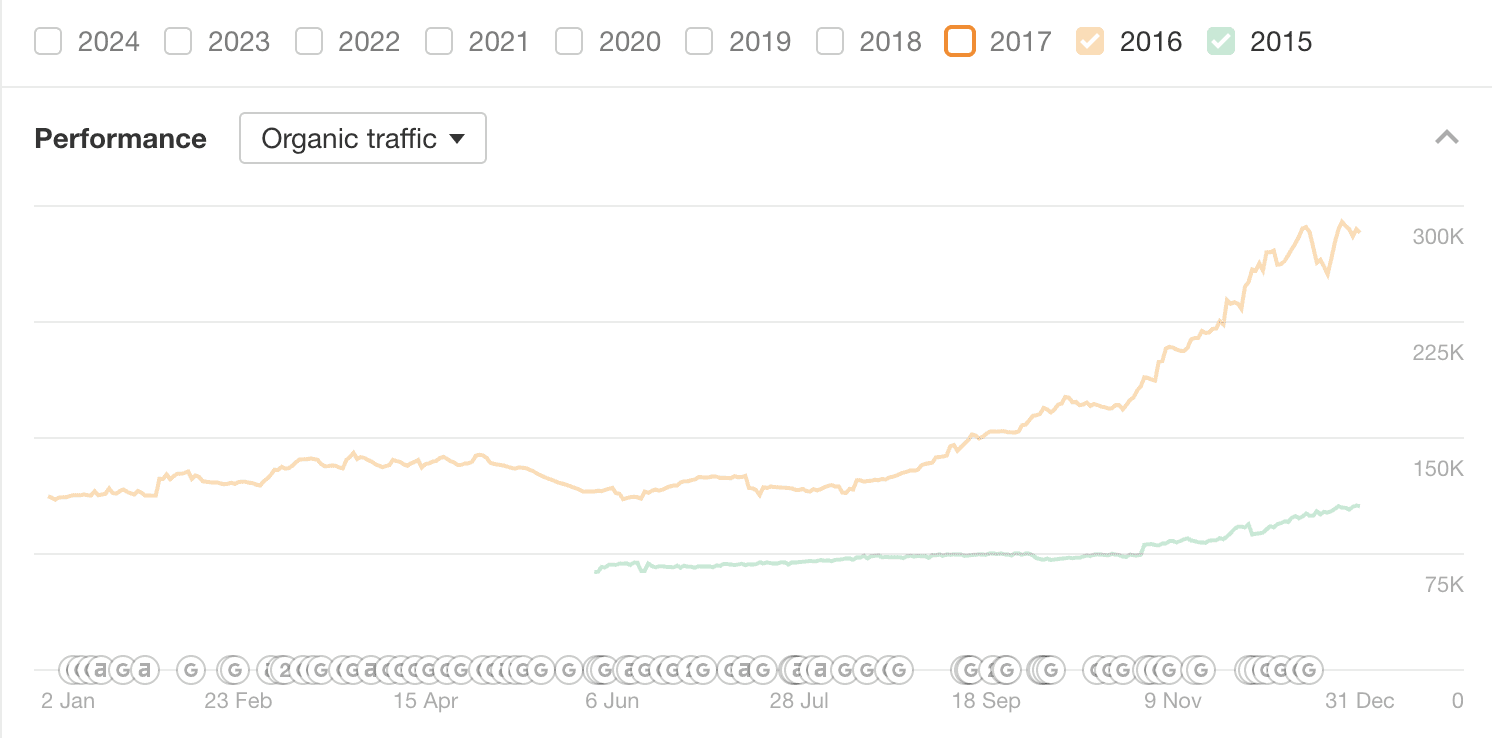
“If there’s one thing I hope startups take away about SEO is that it’s a marathon, not a sprint,” growth leader Ethan Smith says. “Quick-twitch muscles won’t do any good here—in fact, they’ll likely get you into trouble. Endurance and awareness are the attributes that get rewarded with SEO.”
How Strong Are Your Analytics?
“When you build out your programmatic engine, your work will be more and more about analytics.”
Matt Bowers, former head of SEO at Zapier and Zillow, highlights the advantage companies with strong analytics systems hold. By consistently analyzing performance, you can identify what’s working, spot content gaps, and track competitor moves to uncover new opportunities.
Since pSEO generates a large volume of content in a short amount of time, it in effect creates its own dataset for making grounded and confident growth decisions. With strong analytics in place, you can very quickly see what content templates are gaining traction among users and iterate from there.
Companies that invest in traditional SEO, rather than programmatic content, often lack the same level of granularity in their data since their content takes a more piecemeal approach. Or, they require a much longer time frame to gather such insights from their analytics.
Are You Able to Build a pSEO A-Team?
“A strong pSEO team needs skilled engineers, UX pros, data analysts, and SEOs.”
The key roles
The efficacy of your pSEO strategy depends on the team members executing it. Key roles include:
- Engineers: Handle large-scale content management and automate data integration
- Tech SEOs: Optimize programmatic pages for search engines, ensuring they’re structured and indexed correctly
- SEOs: Bring senior expertise in keyword strategy and SERP behavior
- UX specialists: Help create design templates and support a smooth flow to conversion
- Analytics experts: Set up data feedback loops that your decisions will be based on
According to Eli Schwartz, product managers should also be thought of as a key part of the pSEO team. Integrating this role can help build your company’s product in a way that will make programmatic growth natural.
John Egan adds that at companies like Pinterest, the engineers didn’t just execute SEO tasks—they generated their own SEO ideas. Engineers were taught how SEO works, allowing them to contribute directly to the strategy. This helped break down communication gaps between engineers and SEOs. For this reason, in his role at Character.ai, John has also focused on training engineers in SEO.
Building an in-house team vs. hiring a service provider
Many teams debate the merits of building an SEO team internally versus hiring an external service provider. Though there are advantages and disadvantages to both, the biggest differences center around budget, expertise, and strategic control.
According to growth leader John Egan, Pinterest took something of a hybrid approach. His team looked to outsourced SEO professionals for insights on algorithm changes and trends. While these external consultants contributed fresh ideas and initial strategies, Pinterest’s in-house product managers and engineers made the final decisions on SEO strategy.
We compare the differences between investing in SEO in-house and hiring externally in a more comprehensive breakdown below:
Building an In-House Team for pSEO
Advantages
- Control over SEO strategy: Your internal seniors will be the only ones designing your approach.
- Custom-built tools and processes: You’ll be able to tailor your technology and workflows to how you already operate.
- Internal knowledge of the product and market: It takes time to get an agency up to speed with everything that could be useful for content production.
- Develop in-house SEO expertise: Building long-term capabilities and skills within your team is invaluable.
Disadvantages
- High upfront costs: Building an in-house team requires significant investments in hiring, training, and building necessary tools and infrastructure.
- Longer ramp-up time: It takes time to build expertise and establish efficient workflows, especially if your team is new to pSEO strategies.
- Limited scalability: Expanding your team and capabilities may be slower, especially if resources or budgets are constrained.
- Narrower perspective: Internal teams may lack exposure to the diverse strategies and best practices seen by consultants working across multiple industries.
Hiring an External Service Provider
Advantages
- Access to expert knowledge and proven systems: Providers that specialize in pSEO will bring experience from working with multiple companies.
- Faster implementation with tested tools: Solutions that have been used many times before speed up execution.
- Cost-efficient scaling: No need to invest heavily in building internal tools or processes and take the time it takes, or to increase your headcount.
- Advanced analytics and insights: The right vendors will help you gain access to tools for optimizing your content strategy.
- Proven track record with measurable results: Finding a team with established success stories helps ensure that you become a success story as well.
Disadvantages
- Less control over strategy: You may need to relinquish some control over how the SEO strategy is developed and executed, which can lead to misalignment with your brand or goals.
- Potential lack of product/market depth: External providers might not have the same deep understanding of your product or market, leading to less tailored content or strategies.
- Less transparency: Some agencies might not fully disclose their methods or may not integrate seamlessly with your internal processes, leaving you in the dark about certain aspects of the work being done.
Have You Researched a pSEO Solutions Provider?
At daydream, we take the heavy lifting of programmatic SEO off your plate.
pSEO often feels more complex than it should. The process of gathering data, creating content, and optimizing for search engines can be time-consuming, especially without the technical know-how necessary. That’s why we built daydream—to simplify pSEO and help startups execute programmatic strategies more efficiently.
Since our launch in 2023, we’ve been dedicated to producing content that mirrors, even exceeds, human quality. Our mission is clear: to generate authentic, engaging content that resonates with readers while avoiding the common pitfalls of AI-generated content.
If you’re looking for a scalable, high-quality pSEO solution, we’re confident that daydream can help. Our technology and expertise make it easy to execute pSEO strategies seamlessly—without the complexity or common missteps of traditional approaches.
Final Considerations: Alternatives & Complements to pSEO
If you evaluate that pSEO is not the right fit at the moment, there are several alternatives for how to scale. Experts weigh in:
Combine pSEO with other strategies.
“Programmatic SEO should always be part of a larger strategy. It helps grow organic traffic, but other tactics—like content marketing, paid ads, or direct outreach—are essential to completing goals like lead generation and revenue growth.”
Invest in paid marketing.
“Paid can generate brand awareness and demand at scale. When there’s no clear SEO journey, paid ads can be more effective.”
Leverage email and notifications.
“Set up programmatic systems for sending personalized emails and notifications, ensuring a consistent flow of one-on-one communication to nurture leads.”
Optimize for social media search engines.
“Treat social platforms like TikTok and LinkedIn as evolving search engines. Optimizing content for these platforms taps into emerging search behaviors.”
Focus on other platforms.
“Use your pSEO data to uncover opportunities across other platforms, identifying untapped keywords and optimizing content for non-Google channels.”
Scale what’s hard to scale.
“Scale growth strategies beyond SEO by systematizing regular updates to editorial content, or by incorporating high-quality professional photos into your listings.”
Chapter 4How to Start Building Your pSEO Engine
1. Find an Overlap between Your Customer Profile, Audience, and Product
“Start your pSEO strategy by mapping where your product and customer needs meet search demand.”
The foundation of a strong pSEO engine starts with identifying how your product can serve your target audience’s content needs. Understanding this will help guide your content production and ensure that you’re creating valuable resources instead of just producing content for the sake of SEO.
There are three key steps here:
- Define your ideal customer profile (ICP).
- Identify audience search patterns.
- Map out how the pages will drive users into your funnel.
We’ll cover each in more detail below.
Define Your ICP
Your ICP is a concise sketch of who typically buys from you. There’s no need to overcomplicate this step; one or two sentences that summarize the customer’s goals, aspirations, and pain points is enough.
For example, Klover, a financial app that offers payday loans, defines its ICP as “people who are in a complicated financial situation and need access to their money at more convenient intervals.”
In this step, it’s also helpful to outline your core products or features that align with your ICP. For Klover, this includes:
- Instant Cash Advance: Early access to wages
- Points Program: Users accumulate points for sharing data and redeem them for rewards.
- Financial Tools: Features that help users set and track financial goals
Clearlying defining your ICP and the product features most relevant to them will help focus your pSEO content roadmap on addressing the specific needs of your target audience, leading to greater engagement.
Identify Audience Search Patterns
Besides your customer profile, you also need to understand your audience’s search behavior. How do they look for ways to solve their problem—that is, the problem your company offers a solution to? What phrases do they use that relate to your product or service?
Below are two ways to uncover insights:
Analyze Your Existing Organic Traffic
Look at your own site’s search data in Google Search Console to find out what queries are driving the most traffic to your site. You can also use Ahrefs’ Top Pages report to identify your best-performing pieces of content.
The goal is to uncover insights about what your audience is already searching for and finding on your site. You can then potentially expand on that content.
It’s important to note, however, that not all high-traffic queries may be relevant to your product or lead to conversions. As you analyze your site’s current organic performance, be sure to distinguish between content that drives large volumes of traffic and content that drives conversions.
It may be that some of your high-traffic content is irrelevant and does not capture your ICP; it instead attracts people outside of your target audience. In short, focus on keywords and content that are more likely to attract users who align with your ICP and have a stronger intent to engage with your product.
Study Competitors’ Content Strategy
Since your competitors are fighting for the same ICP as your company, it’s a good idea to study their content strategies. Use Ahrefs or Semrush to find out which keywords and pages are driving traffic to their sites. Look for opportunities where competitors are ranking, but where you could offer better or more targeted content.
You can also look for gaps in what your competitors are ranking for—then target those. Agency leader Ethan Smith describes this process as beginning with an “opportunity analysis.” His SEO team maps out all relevant and valuable search terms, and then creates visual analyses of competitor gaps that can be filled.
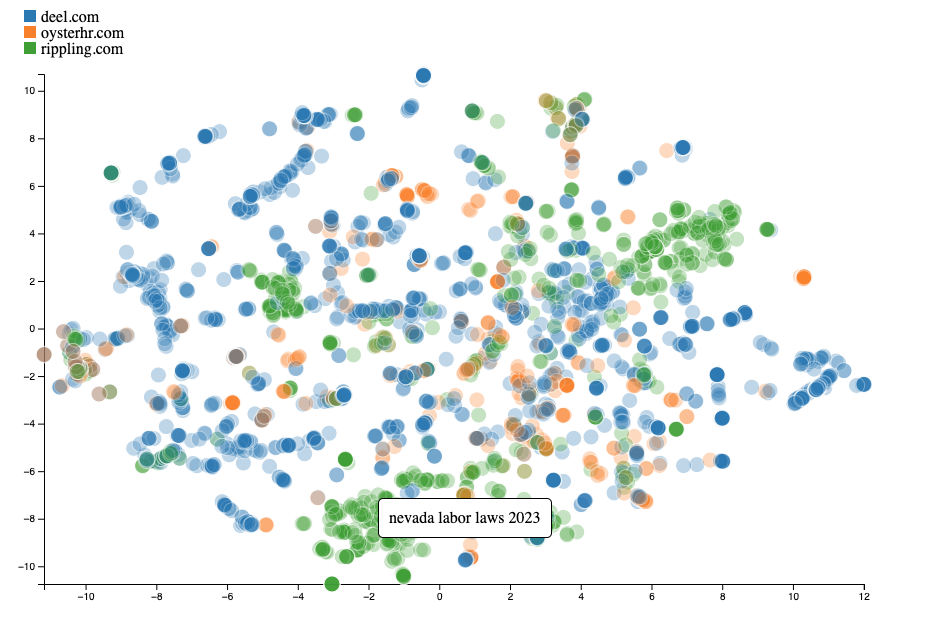
Map out How the Pages Will Drive Users into Your Funnel
“The key to effective pSEO is identifying product features that match user searches, then creating targeted pages that drive users into your product’s funnel.”
To build your pSEO engine, you need to identify specific features of your product that people search for in various ways. Doing so can help ideate the core content topics that can be expanded into long-tail keyword variations.
Continuing our earlier example, Klover could use search patterns such as loan amount or location to generate hundreds or thousands of unique content pages.
Let’s say users are searching for “$100 payday loan in California” or “$500 payday loan in Florida.” Based on these patterns, an appropriate content template could be “[Amount] payday loan in [State].” This template can generate numerous pages that each target a different combination of loan amounts and states.
SEO consultant Eli Schwartz shares some of his thought process behind designing the programmatic strategy for Insight Timer, the largest UGC platform for meditation. Rather than producing general meditation content like Headspace and other competitors, Eli and the Insight Timer team created programmatic pages tailored to specific meditation types. For example, they created pages that aggregated all relevant meditations for keywords like “sound meditation” and “buddhist meditation.”

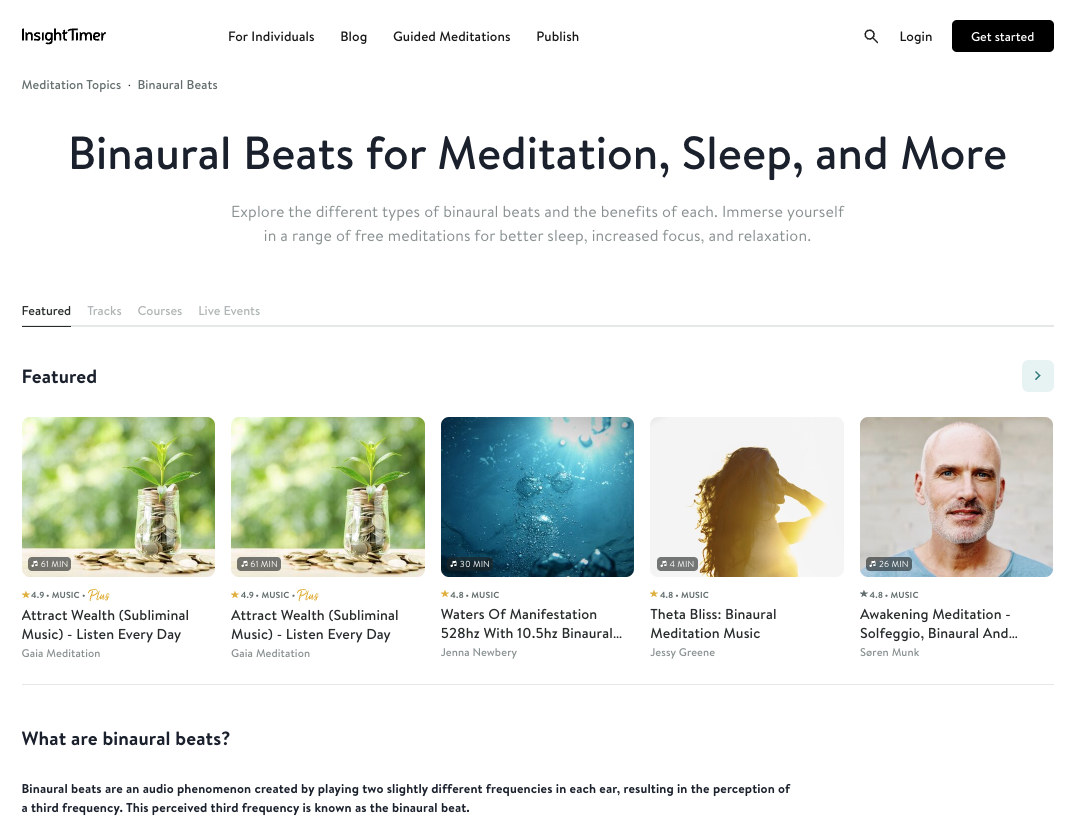
These highly specific, targeted pages brought users directly to Insight Timer’s app, offering them a chance to sample meditations and guiding them to becoming paying customers.
This approach differentiates itself by moving users straight to the product experience, rather than leading them through layers of content marketing first. The goal is to create search-optimized pages that not only generate traffic but also guide users further along the marketing funnel and closer to conversion.
2. Find and Evaluate the Database You’ll Use
“Your programmatic SEO strategy starts with an asset review, identifying the valuable data your company owns or can acquire for scalable content production.”
Conduct an asset review to understand what data you have at your disposal. Whether it’s proprietary first-party data or publicly available information, this will be the foundation of your programmatic content strategy.
For example, an insurance company with detailed information about hospitals and clinics across the country holds a valuable resource that can be turned into programmatic content.
Here are three examples of types of data that can be leveraged for pSEO:
Proprietary Data
Proprietary data is gold for programmatic SEO. If you operate a commerce website, this could include product specifications, or customer stats that your competitors don’t have.
For example, G2 leverages its extensive set of B2B software reviews to create pages comparing different software products like [software company A] vs. [software company B].
Another form of valuable proprietary data can come from customer interviews and conversations, such as customer surveys or anonymized sentiment data.
Publicly Available Data
Publicly available data, when simplified and made more accessible, can be just as powerful.
As mentioned in Chapter 3, Twingate is an example of a company that uses government-published data to create valuable content. It transforms complex public information into easy-to-digest pages, offering a better user experience than the government.
User-Generated Content (UGC)
Another rich data source is UGC. Social platforms and communities like Reddit and Pinterest thrive on UGC, building programmatic content from user posts, reviews, and interactions. This allows companies to generate large volumes of fresh, dynamic content at scale.
3. Narrow Down on a Winning Strategy
“Your pSEO strategy should balance growth and quality metrics.”
The next step is to identify the best strategy for scaling your programmatic content. This decision requires evaluating several factors, from how quickly you can scale to the quality of the content produced. Notice that you’ll need to focus on both growth and quality metrics; doing so will generate better results than if you were to optimize for only one.
Try to score your strategy ideas based on the following metrics:
Growth metrics for scalability of your engine
- Can this strategy scale quickly without bottlenecks?
- Will the content drive traffic for a wide variety of search queries?
- How much content can you generate in a short time?
Quality metrics for maintaining high quality of your content
- Does the content align with user intent?
- Does the content fit one of your customers’ funnel steps?
- Is it detailed and relevant enough to engage users?
- Will it require significant ongoing maintenance?
A high volume of poor-quality content may drive traffic initially, but it won’t create long-term value or conversions. By balancing scalability and quality, you’ll design a pSEO strategy that doesn’t just generate traffic but also delivers meaningful results.
For hands-on walkthroughs of how pSEO has been executed successfully by companies like Wise, Coinbase, Zapier, Canva, and G2, dive into one of the playbooks on daydream’s blog.
4. Create Content Templates for Executing the Strategy
“Each template should be built around structured sections that extract the best insights from your data, scale easily, and drive users toward conversions.”
With pSEO, you’re not simply building templates—you’re designing a framework with distinct sections that repeat across hundreds, even thousands, of pages.
Each template should consist of structured sections that map to key parts of your product or service. These sections should be informed by the data insights you’ve identified and serve a specific purpose.
For example, imagine you manage the website of a large restaurant chain. Your content template should account for the following:
H1, H2, and H3 tags:
- H1: Main topic or keyword (e.g. “Best Restaurants in [City]”)
- H2: Major subtopics (e.g. “Top rated cuisines”)
- H3: Further details or supporting data (e.g. “Chef recommendations”)
Dynamic elements and placeholders for key data:
- Data points, e.g. {average_restaurant_rating}
- Functionality, e.g. {comparison_tool}
- Quotes, e.g. {restaurant_critic_quote}
- Examples, e.g. {popular_restaurant_example}
- Images, e.g. {restaurant_photo}
- User-generated content such as customer reviews or user photos
Interlinking and navigation, for SEO and conversions:
- Related pages, e.g.linking between city restaurant guides
- Key category pages or hub content
- Breadcrumb navigation
- Calls to action (CTAs), e.g.booking a table
Meta information for SEO:
- Title tags, e.g. “{City} Restaurants: Top {Cuisine} Options”
- Meta descriptions, e.g. “Discover the best {cuisine} restaurants in {city} based on first-hand experience from local foodies.”
- Image alt text, e.g. “Interior of {restaurant_name} in {city}”
You can see how template design makes you think about information points like they’re dynamic variables. This is where scale happens. You’ll use AI to plug in information for the variables and produce a large volume of pages.
Wise’s currency converter template is an excellent example of how a well-structured template can scale production and engage users at the same time. Its template dynamically pulls in currency rates, interlinks to relevant resources, and includes clear conversion CTAs.
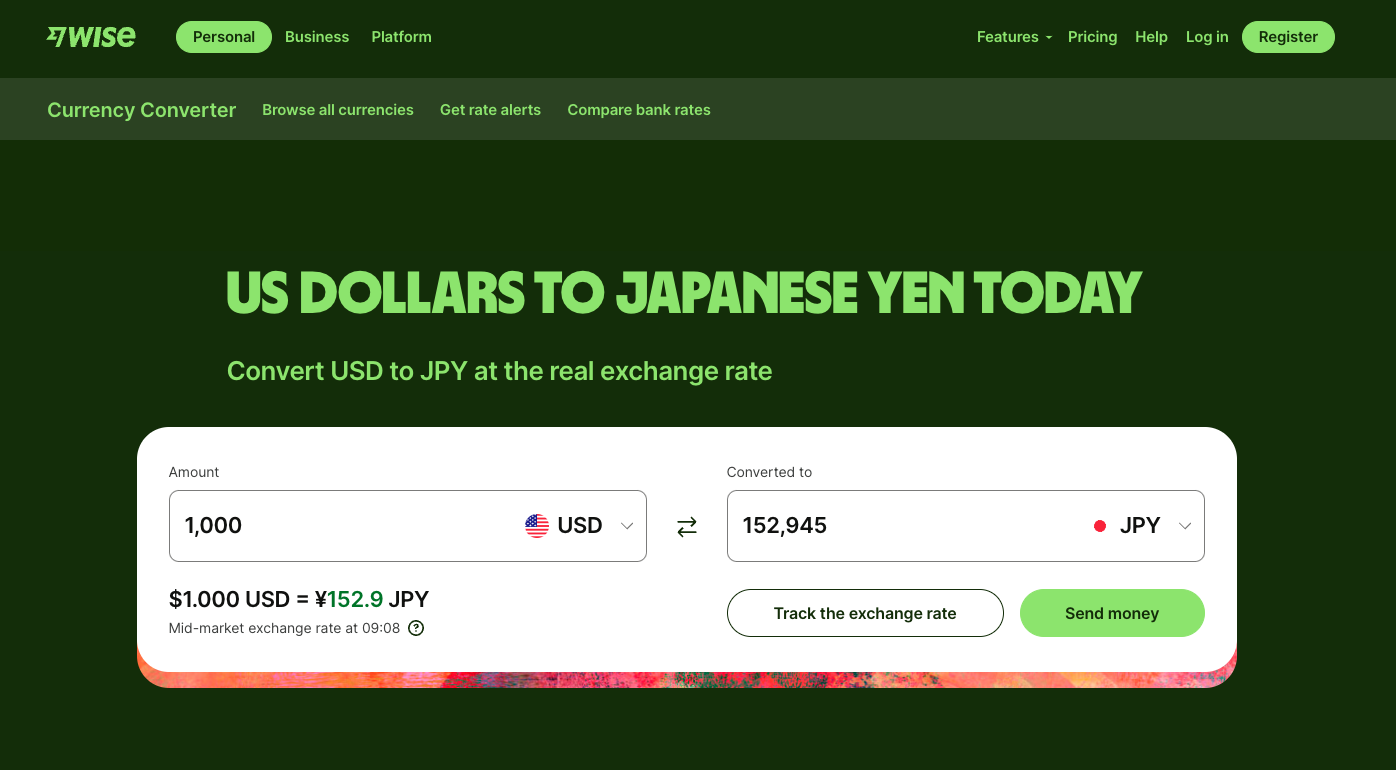
Each currency converter page shows a systematic set of sections that help scale content production, traffic, and conversions. We identify the template’s key elements in the next image.
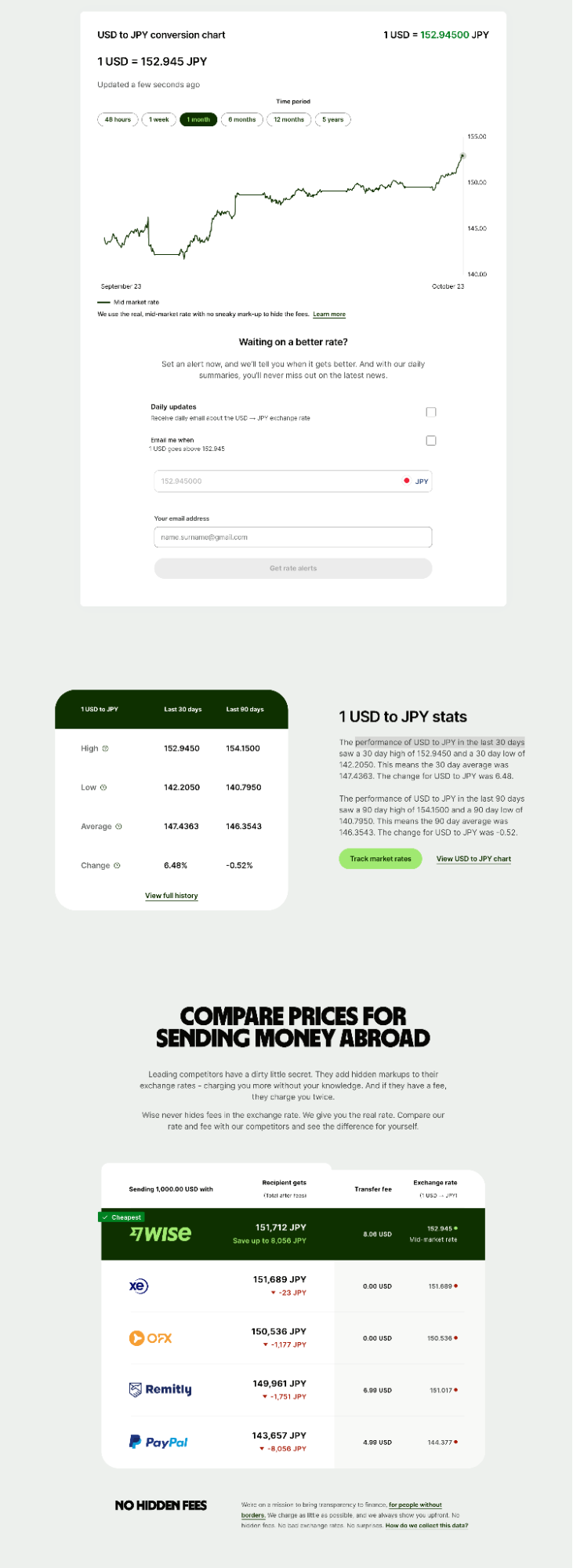
A conversion chart visually shows how exchange rates have fluctuated over time. Below it, Wise captures leads by offering rate notifications via email.
In addition to the chart above, Wise provides a conversion stats section that details the performance of the given currencies, e.g., USD to JPY, in the last 30 to 90 days. This section offers a quick high-level overview of the average change in exchange rate, plus its recent highs and lows.
Further down the page is a comparison table that ranks Wise against competing money transfer services, with Wise positioned at the top. The template is structured such that users immediately find what they’re looking for at the top of the page—currency conversion info—but can also learn more about Wise’s relevant services as they keep scrolling.
When scaling programmatic content, Brian Dean emphasizes starting small with a few adaptable templates. As mentioned in Chapter 1, his team at Exploding Topics relied on 3-5 core templates as the foundation, keeping the structure simple but flexible enough to apply across industries and topics. The templates included sections for data points and user engagement features, making it easy to quickly produce hundreds of pages. This approach streamlined content creation and allowed for rapid scaling without complexity.
John Egan, growth leader with experience at Character.ai, Lyft, and Pinterest, echoes this with standardized core page types at Pinterest—Pin pages, board pages, and topic pages. Those three alone enabled massive programmatic user-generated content (UGC) production. The standardization supported SEO results, and allowed Pinterest to generate fresh, dynamic content at scale while maintaining user interaction.
5. Structure Your Database for the Winning Strategy and Templates
Sharing unique knowledge has always been a differentiator of successful content. The knowledge may be unique because it’s based on your own experience or opinion, or because it’s based on original data from a study you conducted. In pSEO, your database is your source of unique knowledge—and structuring the database is what makes it ready to be leveraged at scale.
Some companies have structured data right from the get-go. Detailed product descriptions and specs are a great example of data that already has a great structure, making e-commerce companies excellent candidates for programmatic content.
But even then, a programmatic engine needs data that’s cleaned up and structured. Some of the practices that can get you there include:
- Data cleaning: Remove duplicate entries that can skew analysis or lead to inaccurate conclusions, fill in missing values. Parse the data for spelling errors and formatting issues that could lead to errors in the generated content.
- Data normalization: Consistent naming conventions, standardized units of measurement, data type consistency via e.g.storing all numerical fields as numbers to facilitate calculations and comparisons.
- Data updates: Schedule regular pulls from your data sources, implement proper authentication and rate-limiting, ensure smooth and compliant data retrieval.
Once you understand your data and have it organized properly, it’s much easier to scale it across different content types and ensure the pages are always relevant and optimized for search intent. You’ll reduce bottlenecks and build a sustainable flow of fresh content.
6. Generate Content
“Leverage AI tools to scale content production, and maintain the human touch.”
Now that you’ve established your templates and structured your data, you can start generating content at scale. The key lies in balancing the scale of AI with human oversight.
Choose the Right AI Partner
Many LLMs are limited in their knowledge scope, which can affect content relevance. Partner with platforms like daydream that combine LLMs with external knowledge sources to ensure your content remains comprehensive and up to date.
Enhance Contextual Understanding
AI can often produce generic or off-brand content due to a lack of contextual understanding. Collaborate with prompt engineering experts to craft detailed, brand-specific prompts that help guide the AI to generate more aligned and relevant content. This ensures your content maintains its depth and quality even when scaled programmatically.
Use AI to Scale, Human Expertise to Refine
AI tools can handle bulk content creation, such as generating landing pages or product descriptions. However, the need for human expertise remains. Becky Westmoreland, SEO Director at Fandom, emphasizes that AI-driven content should be paired with human input to meet the demand for authenticity. Experts review and refine AI-generated content, ensuring it aligns with user intent and brand voice.
Implement Human Reviews and Continuous Learning
Establish a robust review process to minimize the risk of inaccurate or misleading content. Involve subject matter experts from your team to review the AI output. Continuous learning mechanisms should also be put in place, allowing AI to learn from human edits and improving content over time. For complex subjects like health advice, users expect content that has human input and expertise behind it.
Refine the Process for Quality and Relevance
As you scale, continually refine your process. AI tools should be optimized to generate content that matches search intent. Set up feedback loops so your AI learns from human revisions, enhancing quality over time. User communities and internal teams can play a crucial role in maintaining content quality as production ramps up.
Chapter 5How to Scale Your pSEO Engine
The key to scaling any programmatic SEO operation is setting up feedback loops based on your analytics. Analytics are crucial as you scale, as they provide insights about crawling, indexing, internal links, content quality, and content ideas. Analytics also help identify and stay ahead of competitors’ moves and adjust your content production targets.
Optimized Crawling, Indexing, and Interlinking
Scaling your pSEO engine hinges on efficient crawling and indexing, especially since this strategy often involves trying to get thousands of programmatic pages to appear in search results. Internal linking helps clue Google in on which pages are worth the crawl budget.
Optimize page speed
“Improving page speed metrics is a high-ROI investment when you’re trying to get hundreds, or thousands, or millions of pages indexed.”
Scaling pSEO starts with optimizing page speed and executing a technical SEO audit. According to SEO expert Matt Bowers, improving time to first byte and page speed metrics helped his team go from 3 million to 30 million pages crawled per day.
Similarly, growth expert John Egan shares that optimizing for Lighthouse scores and Core Web Vitals was key to Pinterest’s SEO success. By focusing on the technical performance metrics, Pinterest helped its core page types get crawled more and ranked higher.
Aim for quality to avoid “Crawled - currently not indexed” errors
“Indexation errors may suggest that Google reads your pages as thin content.”
One of the biggest challenges with pSEO is ensuring your content doesn’t fall under the “Crawled - currently not indexed” umbrella in Google Search Console. A URL with the “Crawled - currently not indexed” status indicates that Google has seen the page but not indexed it. This error is often associated with “thin content”—Google’s term for content with little or no added value.
Ten years ago, it was significantly easier to launch large volumes of pages without indexation issues. However, as the web has grown exponentially—even more so since ChatGPT launched—Google has raised its standard for indexed content.
To avoid getting your pSEO content filed under the “Crawled - currently not indexed” status, SEO agency leader Igal Stolpner recommends optimizing for content quality rather than quantity. Do not attempt to upload thousands of pages and get them all indexed immediately.
Instead, carefully examine the competitors that already rank for your target keywords and then build programmatic templates with insight from real experts. You should also regularly refresh your content.
Most importantly, figure out a way to create additional value, whether that’s packaging it in a more convenient way, or providing data or insights that only you have in the industry.
As Igal says, “First impression is critical here, and quality should be prioritized over quantity for weeks and months before scaling. Remember that pSEO is a product-first strategy, and Google will be looking to see if users are satisfied, just like with any other SEO strategy. If they are, you can scale. If not, go back to the drawing board.”
Clean up your index
“Ensure that your index rate is high, and that the pages that get indexed are the quality ones.”
On the topic of managing indexation, Ethan Smith, CEO of Graphite and former head of growth at Yummly, shares another crucial strategy: compare your indexed pages to the traffic they generate.
Ideally, your pages should be crawled weekly, with at least 95% of them indexed—unless you’ve intentionally disallowed spiders from crawling them. However, the quality of those indexed pages is just as important as the volume. Google disfavors sites with a significant number of thin or low-value pages, which can hurt your overall SEO performance.
At Yummly, Ethan’s team found several instances of thin pages being indexed without their knowledge. These included duplicate pages from different site versions, such as HTTP vs. HTTPS, or even pages with and without the “www.” prefix. They also discovered that development servers, like DEV1.yummly.com and DEV2.yummly.com, were being indexed, which created multiple versions of their site. Left unchecked, this could have led to massive duplicate content issues, dragging down their site’s overall performance. The solution was to quickly disallow entire directories in the robots.txt file and use Google Webmaster Tools to remove problematic directories.
Keep a close eye on your crawl and index metrics to prevent similar issues. Ethan emphasizes the importance of regularly conducting site hygiene audits. Track indexation rates and take swift action to remove or block pages that don’t meet quality standards. Doing so will prevent thin content from harming your site’s overall performance and ensure that Google prioritizes your most valuable pages.

Get the most out of your internal links
“Flatten your internal link structure.”
According to John Egan, interlinking was a key strategy for managing Google’s crawl at Pinterest. With billions of pages, the focus was on helping Google understand which pages were most important. Internal linking helped direct Google’s attention to the most valuable pages. You can think of it as guiding Google through your site, helping it understand the connections between your pages, so it ranks them accordingly.
On a related note, Ethan Smith emphasizes the importance of flattening your internal link structure. The goal is to distribute your internal links evenly across all pages, rather than letting them pile up on a few popular pages.
If your internal linking focuses solely on recent or high-profile content, other pages get buried. As a result, Google’s algorithms may interpret them as less important.
Instead, make sure to link horizontally and vertically across categories. For example, if you’re promoting an easy-to-use digital camera, don’t just link to other cameras—also link to categories like easy-to-use headphones or TVs.
Systematized Content Updates
“Systematically updating your content quickly becomes just as effective as producing new content, especially when you place variables where new data can be inserted.”
To scale content updates, automate where possible by inserting variables in your templates where new data points can be easily placed. This approach is especially valuable for sites with frequently changing data like product specifications, pricing, or rankings. You’ll also get results from systematizing updates to meta descriptions or additions to internal links.
Brian Dean of Exploding Topics and Backlinko is one expert who recognizes the value of content updates—so much so he was willing to slow down new content production to focus on updating content.
“We shifted roles so writers spent more time updating content they were familiar with,” Brian explains. “Instead of creating a new post every week, we slowed their new content production to allow more time for updates.”
Actionable Analytics
“As you scale, analytics becomes one of the main areas of your work.”
To understand what changes in your content and strategy might be needed, set up a proactive analytics routine. With a growing number of pages, the data about your content’s performance becomes more reliable. A larger dataset provides a clearer picture of trends while reducing the impact of outliers and edge cases.
In other words, with more analytics data to work with, you’ll be able to find content characteristics that drive better engagement and traffic. For example, you may find the word count range that works best, template sections that bring more engaged traffic than others, or relevant subtopics you haven’t covered yet.
Below are metrics to keep a close eye on:
- Conversion rate: Track how well your content leads to the best next step.
- Backlink acquisition: Track both the number of backlinks and the quality of referring domains in your site’s backlink profile.
- Click-through rate from search engine results pages: Measure the effectiveness of your content’s meta descriptions and headlines.
- Bounce rate: Identify content that’s not meeting user expectations.
- Average time on page: Evaluate how engaging and relevant your content is.
- Number of pages published: Ensure your scaling efforts align with growth targets.
Matt Bowers recommends using a 14-month reporting window to smooth noise in the data. As he explains, “Weekly reporting is too granular and often introduces unnecessary fluctuations, so we use longer windows for clearer insights.”
Regular Testing
“Control for quality and volume.”
Avoid launching minimum viable content for initial testing. If content is low-quality, it may fail to rank, but you won’t know whether that’s due to your domain’s limitations or simply the quality of the content. Start with a high-quality version to eliminate quality concerns as a variable.
Then, make sure to test with enough volume. Publishing only a small number of pages—say 10 or 20—won’t provide enough data to gauge performance. A larger sample size, such as 40 or 50 pages, helps uncover clearer patterns of what works and what doesn’t without being skewed by edge cases. Even within a batch of pages, some will drive more traffic than others, and you need enough variation in enough volume of content to be able to test for outliers.
Continuous Stream of New Content
Content isn't a one-time growth investment. With constantly shifting search algorithms, advancements in AI, and new competitors, your content strategy requires continuous investment. So how do you maintain a viable content strategy?
Create a self-sustaining content engine
At Pinterest, users generate fresh content daily by adding new Pins and boards. As its former head of growth John Egan explains, the company leveraged this content for pSEO by building the platform around it. Even today, users continue adding content, helping to drive more traffic.
Similarly, Airbnb integrates programmatic SEO directly into its product by encouraging users to leave reviews, which help amplify Airbnb’s search presence. This instance exemplifies the fruitful collaboration between the company’s product team, engineers, and SEOs—something you can also create within your own team.
Look for ways to maintain authenticity and a human touch
As AI-generated content becomes more prevalent, users will increasingly seek out content with a human touch. To that end, communities and personal experience remain crucial in preserving the authentic, passion-driven exchanges users crave.
For example, take a look at the entertainment site Fandom. It provides comprehensive information on pop culture favorites, including details not available to LLMs.
To prevent content from becoming overly robotic, consider integrating UGC from your users or public communities into your content.
Conduct regular gap analyses
A content gap analysis should not be a one-time project. By regularly analyzing competitors’ strategies, you can spot areas where your programmatic content could expand to.
For example, the coaching and productivity tool BetterUp ranked for the keyword “5-year plan” early on. Competitors took notice and began creating competing content.
Regular monitoring not only helps businesses optimize or refresh content to maintain rankings; it can also identify opportunities for new content.
Above all, focus on content with purpose
As you continue growing your site’s online presence, remember that scaling effectively means creating content with purpose, not just for volume.
Many companies create large volumes of content around keywords without thinking about the user’s actual needs. It’s possible some of these pages may drive traffic, but if that traffic is irrelevant—for instance, it attracts users outside of your target audience—it’s a waste of resources.
Instead, focus on generating content that enhances the user journey and fits meaningfully into your funnel. Avoid producing content that doesn’t align with your user journey.
Bonus: Full Break-Downs of the Most Successful Programmatic Strategies
In daydream’s Library, we publish the most comprehensive collection of programmatic SEO case studies, and we add to it continually.
You’ll find breakdowns of how major brands leverage pSEO, including:
Authors & Contributors
Authors

Thenuka is the CEO of daydream and the author of this course. Much of this course is based on his essays on the daydream blog. Before co-founding daydream, he founded Flixed, as well as other technology startups globally.
Contributors
To make this course the most hands-on and the most comprehensive guide on pSEO, we’ve interviewed a set of amazing experts. They all shared their own firsthand experience with scaling growth programs, and we’ve used that insight throughout the course.









